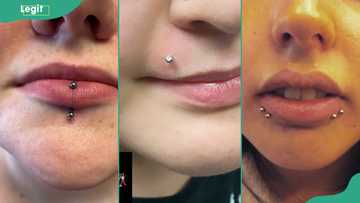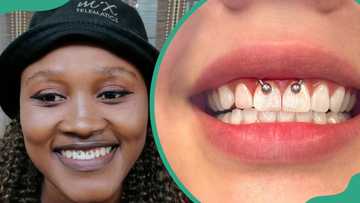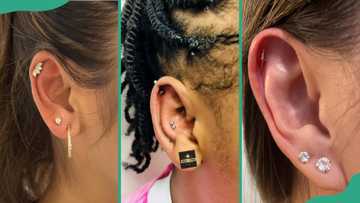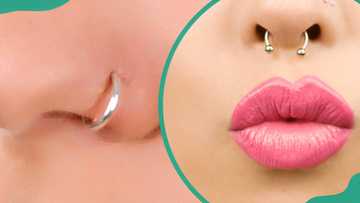Snake bite piercing: a complete guide to what to know about them
Snake bite piercing is a body piercing that involves two symmetrical piercings on the lower lip, resembling snake fangs. These body piercings are gaining popularity as a daring and fashionable form of self-expression. Are you considering getting a snake bite piercing? You need to know everything about them, including their various types and healing process.
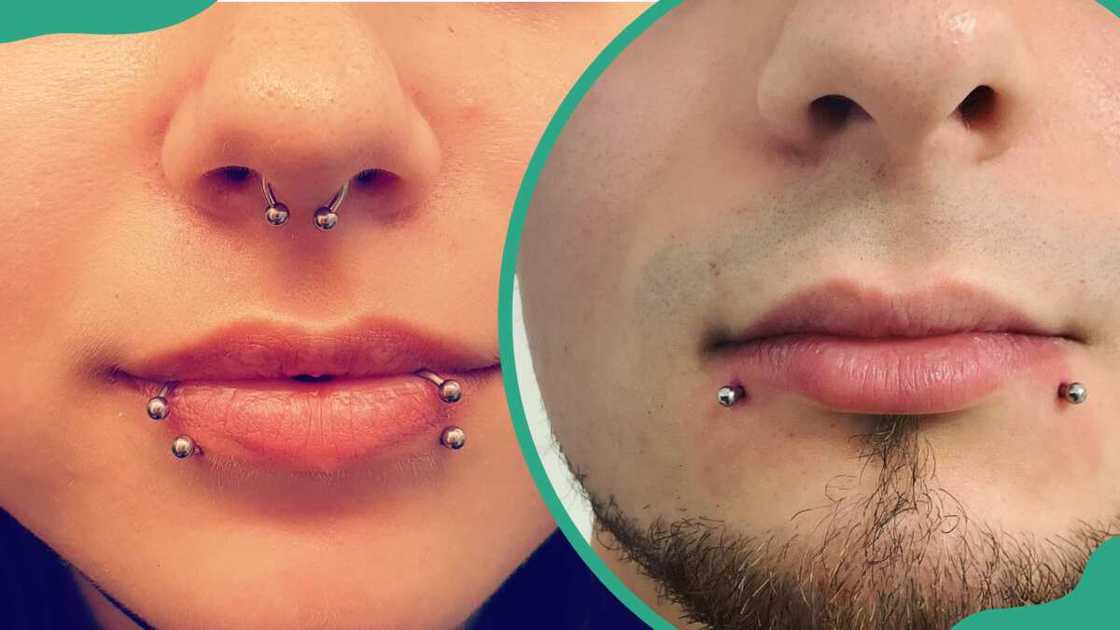
Source: UGC
TABLE OF CONTENTS
- Snake bite piercing
- How painful are snake bite piercings?
- Are snake bite piercings safe?
- How do you eat after a snake bite piercing?
- How long do snake bite piercings take to heal?
Piercings have been significant in various cultures and contexts throughout history. The appearance of snake fangs inspires snake bite piercings and are often symmetrically placed near the outer corners of the lower lip.
Snake bite piercing
Snake bite piercings are two separate piercings on the lower lip, typically spaced evenly apart to resemble the fangs of a snake. Sometimes, people mistake snake bite piercings for other lip piercing types like spider bite or Dahlia piercing.
While snake bite piercings consist of two separate piercings on either side of the lower lip, spider bite piercings are placed close together on one side of the lower lip, resembling the bite marks of a spider. Conversely, Dahlia piercings involve a pair of piercings located at the corners of the mouth, giving an extended smile appearance.
Procedure for a snake bite piercing
When having a snake bite piercing, follow the steps highlighted below.
- The piercer washes their hands and puts on disposable gloves for hygiene.
- Next, they disinfect your lip area and have you rinse your mouth with an antibacterial mouthwash.
- The piercer uses either sterilised reusable or sterile, single-use disposable instruments.
- They mark where the piercings will go and show you for approval.
- Next, a clamp is placed on your lip to hold it steady, and the piercer inserts a needle into the marked spot on your lip.
- They then insert the jewellery into the new piercing and secure it. Once done, the piercer cleans the area around the new piercing.
- They repeat the process on the other side of your lip.
Types of snake bite piercings
There are two main types of snake bite piercings. Learn more about each piercing below:
Ring snake bite piercings
These piercings use circular jewellery, such as captive bead rings (CBRs) or circular barbells. The rings encircle the lip, creating a bold and striking look. This snake bite piercing style is famous for its versatility and the variety of designs available.
Labret snake bite piercings
These snake bite piercings use labret studs, which consist of a flat back plate that rests inside the mouth and a decorative front piece that sits outside. Labret studs provide a more subdued and comfortable option compared to rings. Therefore, they are ideal for those who prefer a more subtle appearance or want to avoid potential irritation from moving parts.
Placement of snake bite piercings
Snake bite piercings can be placed on three main body parts—tongue, ear, and lips.
Snakebite tongue piercing
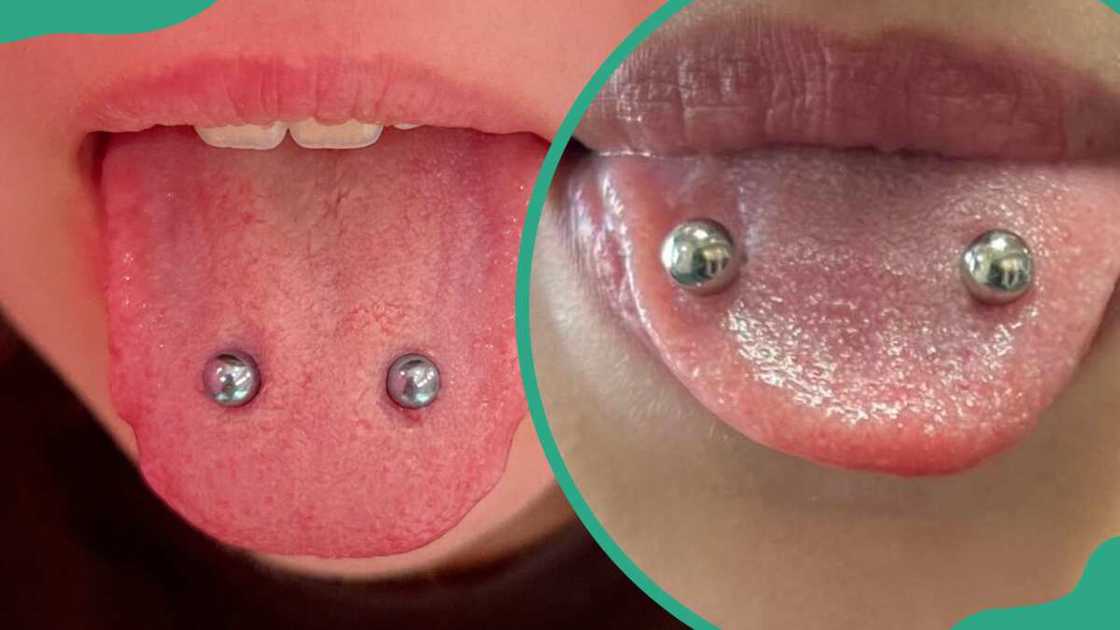
Source: UGC
The tongue snake bite piercing involves two separate piercings on the tongue, positioned symmetrically to resemble the fang marks of a snake. The piercings are usually located towards the front or middle of the tongue, spaced evenly apart.
For the tongue snake bite piercing, the most common jewellery for these piercings are barbells, which can be straight or curved depending on one’s preference. These piercings heal relatively quickly, often within 4 to 6 weeks.
Some potential risks of these body piercings may include swelling, infection, damage to teeth and gums, and speech issues.
Snakebite ear piercing
As the name suggests, ear snake bite piercings refer to two piercings placed on the ear, usually on the lower lobe, upper lobe, or helix. They have a symmetrical pattern that mimics snake bite marks. Some common pieces of jewellery used include studs, hoops, or captive bead rings.
The pain level for ear piercings varies depending on where they have been placed. Cartilage piercings are generally more painful than lobe piercings. Healing times also differ; lobe piercings take about 6 to 8 weeks to heal, while cartilage piercings can take several months.
For proper healing, regular cleaning with saline solution, avoiding sleeping on the piercings, and not touching the jewellery with unclean hands are essential.
Snakebite lip piercing
For the lips, they are mainly done on the lower lip. The pain level for this piercing may vary from one individual to another. You can choose between rings or labret studs for jewellery. And with proper care, the healing time may range between six and eight weeks.
Snake bite piercing healing process
The snake bite piercing healing process depends on whether it is placed on the lips, tongue, or ears. Here is an in-depth look at the healing process of the lips, tongue, and ear snake bite piercings.
Snakebite lip piercings
The initial healing process happens in weeks 1-2, during which you will encounter swelling and tenderness. Cold compresses and anti-inflammatory medications can help manage the swelling. During this timeframe, you should clean the piercings twice daily with a saline solution or a piercing aftercare spray.
The mid-healing stage happens in weeks 3 to 6. At this stage, swelling should decrease significantly. Continue cleaning regularly and monitor for any signs of infection, such as increased redness, pain, or unusual discharge. If swelling has reduced substantially, switch to shorter jewellery to avoid irritation.
The final healing process happens in weeks 6 to 8. Here, the piercing starts to form stronger internal tissue.
Snakebite tongue piercings
The snake bite tongue piercing initial healing happens on days 1 to 7. In this stage, you will experience swelling and discomfort. Rinsing with a non-alcoholic, antiseptic mouthwash or saline solution after meals can help. To facilitate faster healing, you should stick to soft, cold foods and avoid dairy, alcohol, and smoking.
The mid-healing process happens in weeks 2 to 4. Here, swelling should lessen, and eating should become more manageable. The final healing happens in weeks 4 to 6 when the internal tissue continues to heal and strengthen.
Snakebite ear piercings
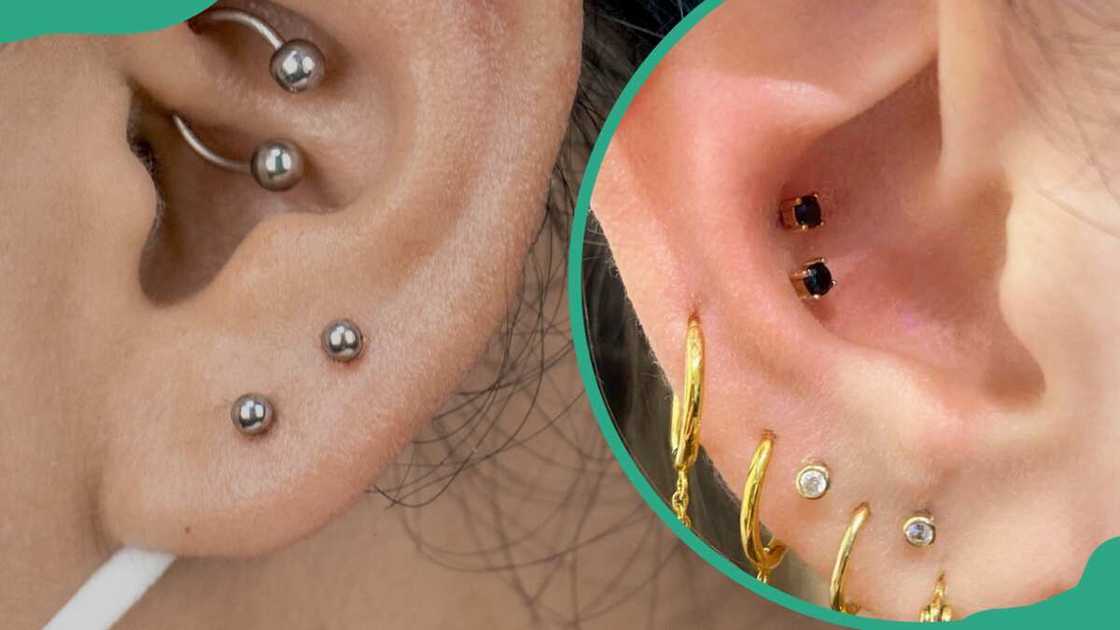
Source: UGC
In weeks 1 to 2, you should expect mild swelling and soreness. Clean the snake bite piercing scar twice daily with a saline solution. The mid-healing for lobes happens in weeks 3 to 8 and 3 to 12 months for the cartilage. Note that lobes generally heal within 6-8 weeks, while cartilage piercings can take several months.
How painful are snake bite piercings?
People with snake bite piercings rate the pain around 3–5 on a pain scale, with 10 being the highest. Proper aftercare and pain management strategies can significantly ease the healing process. To effectively manage the pain, you can apply the remedies shared below.
- Cold compresses: Applying cold compresses can help reduce swelling and numb the area.
- Over-the-counter pain relievers: Ibuprofen or other anti-inflammatory medications can help manage pain and swelling.
- Avoiding irritants: Avoid spicy foods, alcohol, and smoking for lip and tongue piercings. For ear piercings, avoid sleeping on the pierced side.
Are snake bite piercings safe?
Snake bite piercings can be safe if performed by a professional piercer and with proper aftercare. However, like other body modifications, they come with risks. The risks for snake bite piercing are higher than ear bite piercing because the mouth contains more bacteria. The snake bite piercing is also more prone to irritation or trauma due to its location.
How do you eat after a snake bite piercing?
After getting a snake bite piercing, you can eat soft, cold foods for the first few days to help soothe your mouth and reduce swelling. Such foods include yoghurt, mashed potatoes, scrambled eggs, smoothies, and soups. Drinking plenty of water also helps keep your mouth clean and reduces swelling.
Additionally, it is advisable to stay away from hot beverages, alcohol, spicy foods, and tobacco products as they can irritate the piercing and prolong healing. You can also drink beverages through a straw to minimise contact with the piercing.
How long do snake bite piercings take to heal?
Snake bite piercings typically take about 6 to 8 weeks to heal fully, but this can vary depending on several factors, including individual healing rates, aftercare practices, and overall health.
The decision to get a snake bite piercing boils down to personal choice. All it takes is to endure brief discomfort, which you can manage with proper aftercare. Ensure you choose a credible piercer and follow the correct aftercare procedures for a safe and successful experience.
Legit.ng recently published an exciting post about rook piercings. Rook piercings have gained significant popularity in recent years, becoming a sought-after choice for individuals seeking unique and stylish ear piercings.
These piercings are one of the more unusual inner-ear piercings delicately placed within the inner ear. They involve creating a small hole through the thick cartilage fold between the ear's inner and outer conch. Do rook piercings heal easily? Find out everything in the article.
Source: Legit.ng



